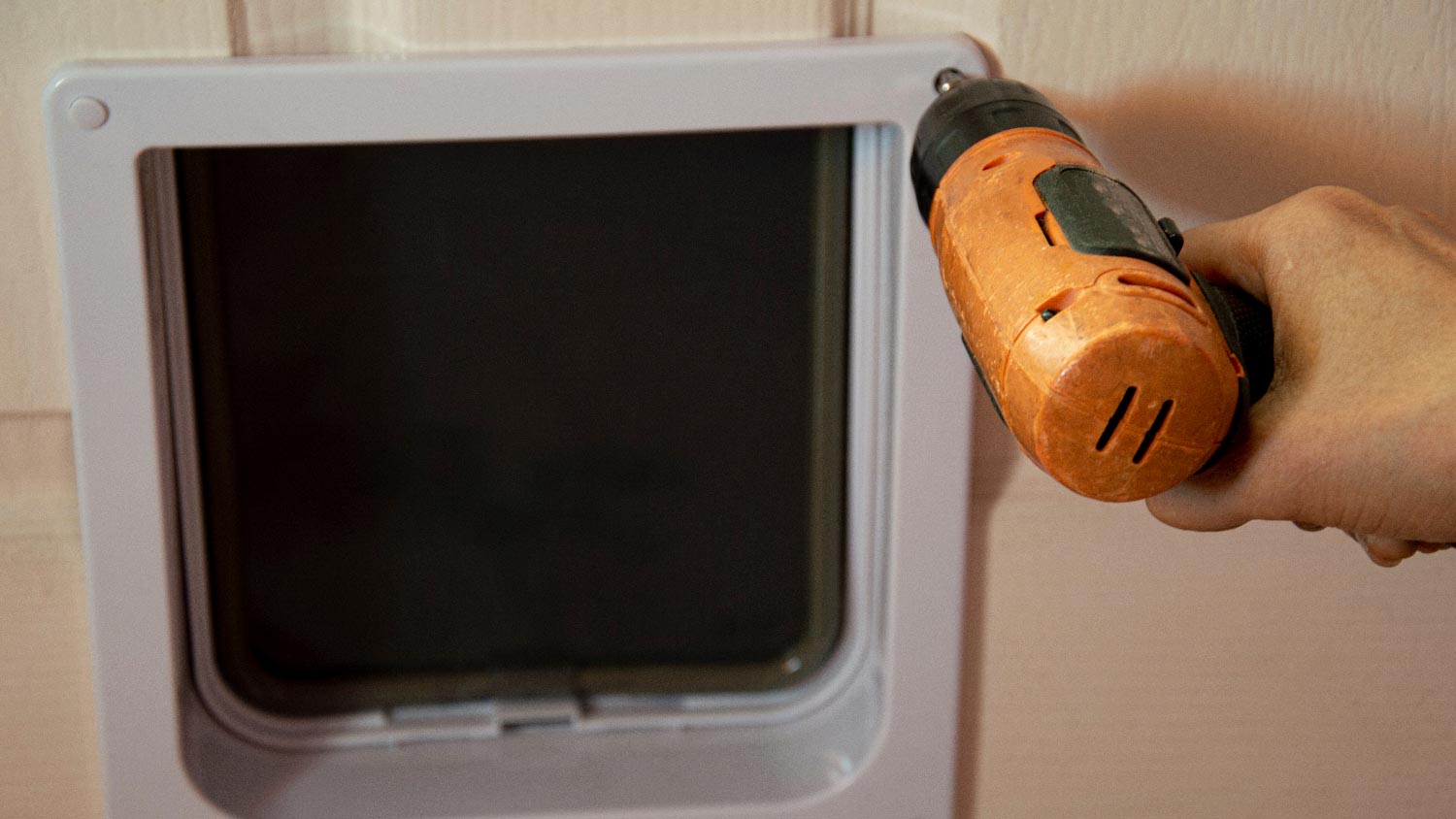
Wondering about the cost to hire a handyman? Discover prices, key cost factors, and money-saving tips to help you plan your next home project.
Call a handyperson with carpentry experience to install a pet door


Your new puppy is finally potty-trained, but now she keeps whining at the back door to go outside and play, making you wish there was a way she could let herself out. When it’s time to give your furry family member the freedom to visit the yard as often as she needs, consider installing a doggy door. If you’re wondering who installs doggy doors, wonder no more — you can hire a handyperson to install this time- and sanity-saving feature.
Generally speaking, the process of installing a pet door into an existing door, or replacing an existing door with a pre-installed doggy door, is not difficult for someone with a little bit of carpentry experience. However, hiring a professional handyperson who installs pet doors can save you time and won’t cost too much. On average, a handyperson can complete the job within a couple of hours, costing around $75 to $300 for total labor (assuming you buy the pet door yourself).
In addition, they can assess ways to make the door more secure, bug- and pest-proof, and energy-efficient.
Door contractors are certainly qualified to install doggy doors, but their hourly labor costs are typically much higher than a handyperson, at an average of $70 to $125 an hour compared to $30 to $75 for a handyperson.
Hiring a door installation contractor is a good option if you’re installing a new door that involves changing the size of the door frame or if there are other structural issues of concern.

Dog doors and cat doors installed on exterior doors are quite similar — they may even be the same door for a large cat and a small dog. A handyperson who can install a doggy door can install a cat door just as easily. With cats, a cat door can be a good idea for interior doors as well, to allow access to a litter box in an otherwise closed room, for example.
The process of installing a pet door depends on where it’s located and if it’s a pre-installed model. Once you’ve chosen the best doggy door option for your home, your handyperson can get to work.
Your handyperson will complete an in-door installation by doing these steps:
Remove your home’s door and mark the pet door placement.
Drill holes for the mounting hardware.
Use a hand saw to cut out an opening for the pet door and sand down any rough spots.
Place the pet door frame, check for a perfect fit, and make adjustments as necessary.
Caulk the frame into place.
Place your home’s door back into its frame.
After determining the best location for your pet door, your handyperson will take the following steps:
Cut out the drywall.
Build a header and its support and cut out the sheathing with a reciprocating saw.
Patch the drywall and install the interior panel of the pet door with the kit’s screws.
Weatherproof the opening and flash the fill.
Apply spray foam to prevent water leakage.
Install the outside frame and then cut and install the aluminum liner.
Install the head and side liners, and fasten the exterior trim to finish the project.
A successful pre-installed pet door addition requires your handyperson to do the following:
Remove the existing pet door and its hinge pins.
Use the existing door to mark the hinge points on the new door.
Mark the lockset location and make any necessary adjustments to the new door using a saw or planer.
Install the hardware, which usually involves chiseling the wood and drilling holes for the lockset and latch.
Paint the door in your requested color.
Allow the door to dry, and then prop it up using wood shims.
Place the hinge pins.
Place the lockset and test the door to make sure it swings freely.
While it’s tempting to flex your drill skills, there are several reasons why it’s better to hire a local handyperson or pet door installer near you for this project.
Speed: A professional will be able to complete this job in just a couple of hours, saving you energy and time.
Maximum Energy Savings: An experienced handyperson can install proper caulking and weatherstripping to prevent energy loss.
Expertise: Installing a pet door in a wall (versus a door) is more complicated, as is installing one in a glass door. A local handyperson who specializes in carpentry should have no trouble tackling the job and will be able to advise as to which option is best for your home.
Safety: If you’ve never drilled into a wall before and don’t understand the ecosystem that lies within, you could run into some big problems if you hit a pipe or wiring. A handyperson will know how to check for any potential hazards.
From average costs to expert advice, get all the answers you need to get your job done.

Wondering about the cost to hire a handyman? Discover prices, key cost factors, and money-saving tips to help you plan your next home project.

Discover wheelchair ramp cost estimates, including installation, materials, and tips to save. Learn what impacts your price and how to budget for your project.

Find out how much it costs to build a chicken coop—whether you've got a few hens in your backyard or a big, self-sustaining flock—with our expert guide.

Whether you need to hang a picture or mount a TV, this step-by-step guide on how to drill into brick will make the entire process a breeze.

A handyperson has the best home improvement tips, tricks, and hacks. We share advice that will help you put a handyperson’s touch on different DIY projects.

Have a home repair problem? A highly rated handyman service shares 4 easy DIY tricks you can try yourself before spending money on a handyman service.